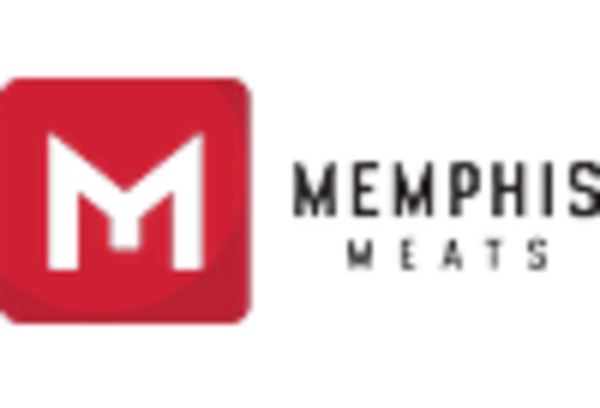The Artificial Meat Market is currently characterized by a dynamic competitive landscape, driven by increasing consumer demand for sustainable protein sources and advancements in food technology. Major players such as Beyond Meat (US), Impossible Foods (US), and Memphis Meats (US) are at the forefront, each adopting distinct strategies to enhance their market presence. Beyond Meat (US) focuses on innovation in product development, continuously expanding its portfolio to include new flavors and formats, thereby appealing to a broader consumer base. Meanwhile, Impossible Foods (US) emphasizes partnerships with food service providers to increase accessibility and visibility of its products, which appears to be a strategic move to penetrate the mainstream market. Memphis Meats (US), on the other hand, is concentrating on scaling its production capabilities through significant investments in bioreactor technology, which may enhance its operational efficiency and product availability.
The business tactics employed by these companies reflect a concerted effort to optimize supply chains and localize manufacturing processes. The market structure is moderately fragmented, with a mix of established brands and emerging startups vying for market share. This fragmentation allows for diverse product offerings, yet the collective influence of key players like Beyond Meat (US) and Impossible Foods (US) is shaping consumer preferences and driving innovation across the sector.
In August 2025, Beyond Meat (US) announced a strategic partnership with a leading fast-food chain to introduce a new line of plant-based burgers. This collaboration is significant as it not only enhances Beyond Meat's visibility but also positions it to capture a larger share of the fast-food market, which is increasingly leaning towards plant-based options. The partnership is likely to bolster sales and reinforce the brand's commitment to making plant-based diets more accessible.
In September 2025, Impossible Foods (US) launched a new product line aimed at the retail sector, featuring ready-to-cook meal kits that incorporate its plant-based meat. This move is indicative of a shift towards convenience in consumer preferences, suggesting that Impossible Foods is keen on tapping into the growing trend of home cooking. By offering meal kits, the company may enhance customer engagement and loyalty, while also diversifying its revenue streams.
In July 2025, Memphis Meats (US) secured a substantial investment to expand its production facilities, focusing on cell-cultured meat. This investment is crucial as it underscores the growing confidence in lab-grown meat technologies and positions Memphis Meats to meet the anticipated surge in demand for sustainable meat alternatives. The expansion could potentially lead to lower production costs and increased market competitiveness.
As of October 2025, the competitive trends within the Artificial Meat Market are increasingly defined by digitalization, sustainability, and the integration of artificial intelligence in production processes. Strategic alliances are becoming more prevalent, as companies recognize the value of collaboration in enhancing innovation and market reach. Looking ahead, it appears that competitive differentiation will increasingly pivot from price-based strategies to a focus on technological advancements, product innovation, and supply chain reliability, reflecting a broader shift in consumer expectations towards quality and sustainability.


















Leave a Comment